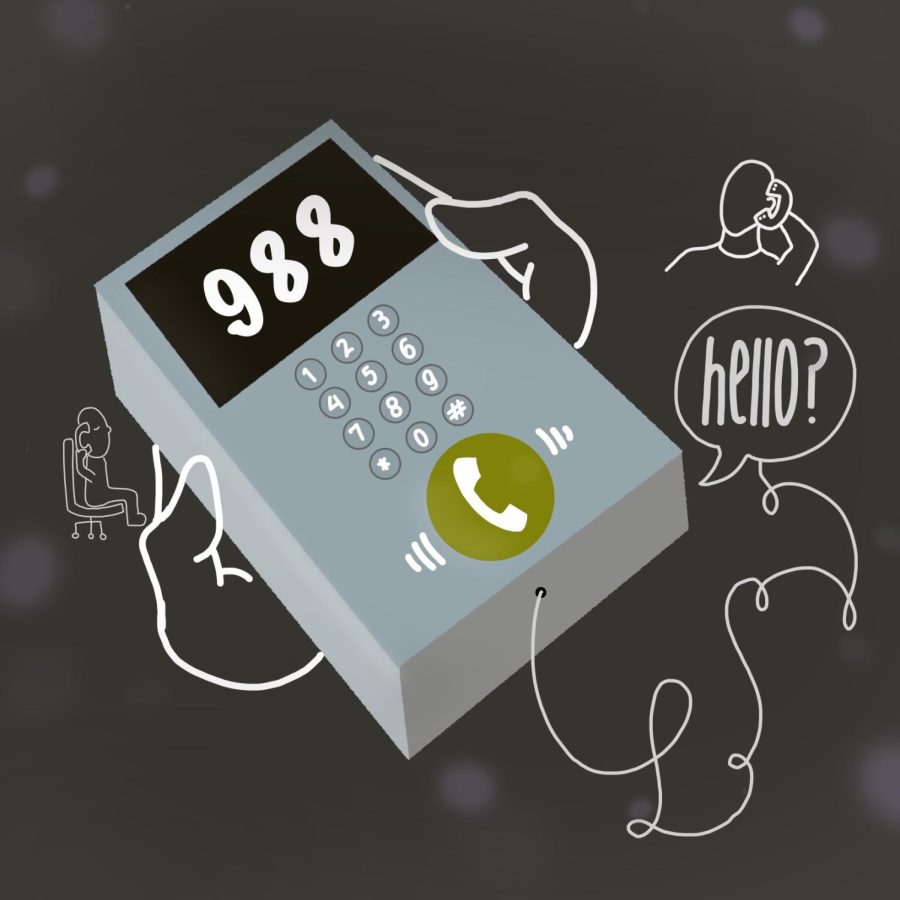New suicide hotline key to raising awareness
Students, teachers reflect on mental health awareness
Ramaswamy
Suicide hotline number changed to 988 instead of the previous 10 digit number. Calls to the hotline jumped 45% after the change
The national suicide hotline was changed to 988 on July 16th in attempt to make it more accessible and effective. Within months of the change, the hotline experienced a 45% increase in calls received.
In 2020, the suicide hotline was created to provide all Americans with a number to call during a mental health crisis. This was a huge step towards mental health awareness and support in the country, but the eleven-digit number was difficult to recall during an emergency. Therefore, to solve this issue, the hotline was changed to 988 on July 16, 2022.
At high schools such as New Trier, sponsors of clubs are making efforts to provide students with opportunities to educate others on the mental health resources available. Erika’s Lighthouse, for example, is a place where students are able to connect and advocate for mental illness.
The non-profit organization was founded after a teenage girl, Erika, died by suicide in 2004. Erika’s parents went on start this organization to create suicide awareness programs for schools nationwide.
Steven Rish, the sponsor of Erika’s Lighthouse, said that their mission is to “promote good mental health and destigmatize depression and mental illness.”
Although Erika’s Lighthouse has helped the community immensely, suicide is now deemed the second-leading cause of death for teens in America.
In just the past two years, the overall rate of suicide in America has increased 4%. For males ages 15 to 24 specifically, this rate has spiked up 8%.
This is why many believe Erika’s Lighthouse’s mission is so relevant in high school environments: students are looking to shine a light on mental health now more than ever. Because the suicide hotline update is so new, the club members are beginning to dive into the topic.
One idea that is being discussed among sponsors and club members is introducing the suicide hotline to the student IDs. The concept was first introduced in Connecticut high schools and colleges.
Connecticut school faculty look to support students after undergoing economic, family, and health stressors during the pandemic. One method of support is printing the updated suicide hotline on the back of student IDs.
Rish said, “It certainly can’t hurt to have those resources quickly and easily available for students because they do have their IDs, and there’s really nothing on the back. I think it’s a great idea, reminding kids where to find help if they need to.”
This view is shared by some students as well.
An active club member, Ella White, said, “I love the idea of making that more normalized because I had no idea that 988 was even going to become a number.”
However, White questions whether students would benefit from a formal announcement of the hotline addition to the ID. Without being notified, students may not notice a difference to the back of the IDs.
She says, “there has to be some sort of context, like an announcement in advisory” that would provide additional information on the hotline’s purpose and relevance.
That is where Erika’s Lighthouse plans to step in: acting as that voice of advocation for the suicide hotline and mental health resources at New Trier.
Since the start of the club, Erika’s Lighthouse has reached a total of about 150 advocates. Starting with only two students, the club has rapidly expanded, especially in the past couple of years.
Part of the reason, Rish believes, is from the increase in mental health awareness during the Pandemic. After almost two years of isolation, there was a collective decline in mental health among students, and many are jumping at the opportunity to normalize the topic.
“[Since the pandemic], I think there has been a lot more interest in mental health. We’re learning how to be more nuanced about how to manage stressors and take good care of ourselves.”







































